by Verne R. Albright
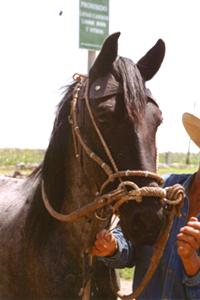 Prior to the seventeenth century, most of the world's horses were naturally gaited. Horses that trotted were the exception, and "Boneshakers" as they were called were considered suitable only as pack animals or mounts for servants. Almost all traveling was done on horseback. Since most people knew very little about riding, a smooth riding horse was a necessity. Even Knights - who required trotting horses for battle - often kept a naturally gaited horse which he would ride when traveling, leading his trotting horse behind.
Prior to the seventeenth century, most of the world's horses were naturally gaited. Horses that trotted were the exception, and "Boneshakers" as they were called were considered suitable only as pack animals or mounts for servants. Almost all traveling was done on horseback. Since most people knew very little about riding, a smooth riding horse was a necessity. Even Knights - who required trotting horses for battle - often kept a naturally gaited horse which he would ride when traveling, leading his trotting horse behind.
Following the seventeenth century, the uses for trotting horses increased. Networks of roads were built, and people began to travel by horse-drawn vehicles rather than on horseback. Since a horse that trots is more suitable than a gaited horse for pulling a wheeled vehicle, the breeding of trotting horses was increased at the expense of gaited horses. At about the same time, great expanses of land were devoted for the first time to cattle raising, and the horse took on importance as a tool for working the cattle. Here again the trotting horse has a greater advantage over the gaited horse, and even more emphasis was put on the breeding of horses that trotted. Almost simultaneously, worldwide popularity was bestowed upon horse racing, yet another activity where gaited horses do not excel.
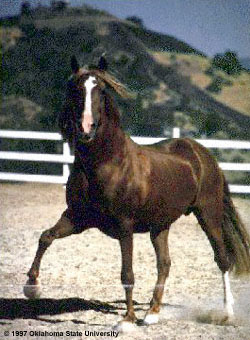 As the seventeenth century opened, it was unusual to see a horse that trotted. At the close of the same century, it was unusual to see a horse that did not trot. It was one of the most unusual transformation that horse breeding has ever seen.
As the seventeenth century opened, it was unusual to see a horse that trotted. At the close of the same century, it was unusual to see a horse that did not trot. It was one of the most unusual transformation that horse breeding has ever seen.
As the world's horsemen moved from naturally gaited horses to trotting horses, the Peruvians continued to esteem and breed their naturally gaited "Caballo Peruano de Paso". The Peruvian Paso horse descended from the bloodstock which was introduced to Peru from the Spanish, who at the time were the foremost horse breeders in the world. The Spanish horses brought to Peru blended the Barb, the Friesian, the Spanish Jennet, and the Andalusian. In Peru these Spanish horses were bred to produce the purest link that the modem world has with the once populous gaited horses. For several centuries, no outside blood has been introduced into the Peruvian Paso breed, and it is now the only naturally gaited breed in the world that can guarantee its gait to 100% of its offspring. Every purebred Peruvian horse has the inherited gait, which is the trademark of the Peruvian breed.
 In recent years, the world's horsemen have begun to rediscover the pleasures of naturally gaited horses; and horse fanciers from many nations are turning to the Peruvian Paso horse as the ideal mount for the twentieth century horsemen. Thanks to its unique, inbom, four-beat lateral gait, the Peruvian horse is the smoothest riding horses in the world. He is also one of the showiest of all horses because of an inner pride and energy that make him travel with a style and carriage as if always "on parade". The temperament of the Peruvian horse is one of the world's best, thanks to a long standing Peruvian practice of not breeding animals that have an unsuitable disposition. In addition, the Peruvian is the only horse in the world with "termino" , which is a graceful, flowing movement in which the forelegs are rolled towards the outside as the horse strides forward, much like the arm motion of a swimmer. "Termino" is a spectacular and beautiful natural action.
In recent years, the world's horsemen have begun to rediscover the pleasures of naturally gaited horses; and horse fanciers from many nations are turning to the Peruvian Paso horse as the ideal mount for the twentieth century horsemen. Thanks to its unique, inbom, four-beat lateral gait, the Peruvian horse is the smoothest riding horses in the world. He is also one of the showiest of all horses because of an inner pride and energy that make him travel with a style and carriage as if always "on parade". The temperament of the Peruvian horse is one of the world's best, thanks to a long standing Peruvian practice of not breeding animals that have an unsuitable disposition. In addition, the Peruvian is the only horse in the world with "termino" , which is a graceful, flowing movement in which the forelegs are rolled towards the outside as the horse strides forward, much like the arm motion of a swimmer. "Termino" is a spectacular and beautiful natural action.
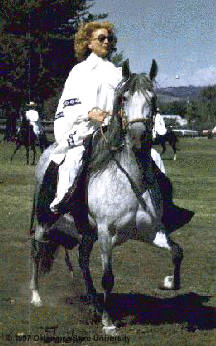 The gait of a Peruvian horse can be as slow as a walk or as fast as an extended trot or slow canter. Both the gait and the flashy leg action are completely natural. They are not induced or aided in any way by artificial training or devices. In fact, both Peru and the United States, Peruvian horses are shown without shoes and with a short, natural hoof.
The gait of a Peruvian horse can be as slow as a walk or as fast as an extended trot or slow canter. Both the gait and the flashy leg action are completely natural. They are not induced or aided in any way by artificial training or devices. In fact, both Peru and the United States, Peruvian horses are shown without shoes and with a short, natural hoof.
Peruvian horses come in all basic, solid colors as well as greys and roans. The breed, because of its direct link to the Barb horse, has some striking color tones and shades. The average height of the Peruvian is between 14 and 15 hands, and the weight is commonly between 900 and 1,100 pounds ... about the same as Morgans and Arabians.
Ride in Style
by Heinz Reusser
Only thirty some years ago the first of the worlds most exciting horses were introduced to the United States - the "Caballo Peruano de Paso", the Peruvian Paso Horse. Since then thousands of North American horsemen and horsewomen have begun to rediscover the great pleasures of naturally gaited horses; and horse fanciers throughout the country are turning to the Peruvian horse as the ideal mount for the twentieth century horsemen. Thanks to it's unique four beat lateral gait, the inherited trademark of the breed, the Peruvian horse is the smoothest riding horse in the world today. He is also one of the showiest of all horses because of an inner pride and energy which makes him travel with a style and carriage as if always "on parade". The "termino", a graceful, flowing movement in which the forelegs are rolled to the outside as the horse strides forward is unique to the breed and completely natural. Thanks to a long standing practice of not breeding animals with an unsuitable disposition, the Peruvian horse has one of the world's best temperaments. A long and often intriguing history adds to the excitement of owning a Peruvian horse.
A Long and Proud History
The introduction of the Spanish horse to the American continent was carried out by the Conquistadors in their quest to conquer the different native civilizations. The first horses were brought to the island of Santo Domingo by Christopher Columbus in 1493 to establish the first breeding operation. The horse raising activities were soon extended to new colonies in Central America to satisfy the needs of mounted troops and in a few years it was no longer necessary to import horses from Spain. For the conquest of Peru in 1532 Francisco Pizarro obtained 25 stallions and the same number of mares from the Royal stables in Jamaica. According to his secretary, he left Panama with 37 horses and headed for the northern coast of Peru. After the arrival of reinforcements from Panama he undertook his march to Cajamarca, the seat of the Inca government, with only 62 horses. In the years that followed the fall of the Inca empire, many Spanish settlers began arriving in Peru, attracted by the fame of it's treasures. The new settlers also brought with them their horses from Central America. By the time many large haciendas flourished, their wealthy owners could afford to improve their stock with the best horses available directly from Spain.
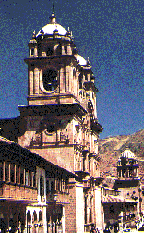 At the time of the conquest of America this Spanish horse, the classic Andalusian, was the most outstanding breed of riding horses existing in Europe. This horse had been developed over many centuries by crossing the Iberian horse, an old breed of native riding horses, with the Berber (Barb) horse brought from the mountains of North Africa by the Moorish invaders. In Peru, the classic Andalusian horse became the foundation for the Peruvian horse, which has kept most of the characteristics that made the Andalusian so valuable during the conquest of South America. It is interesting to note here that the Andalusian horse in Spain has changed through the influence of other European breeds introduced by foreign Royal Houses that ruled Spain for two centuries. Four hundred years of selective breeding and the influence of geographic and climatic conditions in Peru have improved the harmonious gait, the smooth ride and the gentle disposition that have become the most outstanding characteristics of the Peruvian horse.
At the time of the conquest of America this Spanish horse, the classic Andalusian, was the most outstanding breed of riding horses existing in Europe. This horse had been developed over many centuries by crossing the Iberian horse, an old breed of native riding horses, with the Berber (Barb) horse brought from the mountains of North Africa by the Moorish invaders. In Peru, the classic Andalusian horse became the foundation for the Peruvian horse, which has kept most of the characteristics that made the Andalusian so valuable during the conquest of South America. It is interesting to note here that the Andalusian horse in Spain has changed through the influence of other European breeds introduced by foreign Royal Houses that ruled Spain for two centuries. Four hundred years of selective breeding and the influence of geographic and climatic conditions in Peru have improved the harmonious gait, the smooth ride and the gentle disposition that have become the most outstanding characteristics of the Peruvian horse.
Today's horse was mainly developed to satisfy the need for a smooth and comfortable ride when overseeing plantations and traveling from one settlement to another. The horse has been kept in a more pure state as there was no need to cross with other breeds to produce taller, heavier or faster horses as was the case in other countries such as Mexico, Argentina or the United States. For hundreds of years many generations of breeders in Peru have contributed to keep, maintain and improve this outstanding breed. Now that the interest in the Peruvian horse has extended to many other countries in the world, with great emphasis in the United States, the breed is getting new support to carry it further. Today's breed standard helps to preserve the qualities of the breed and contributes to setting directions for the future.
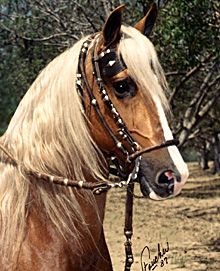 A Picture of the Perfect Horse
A Picture of the Perfect Horse
The Peruvian horse projects an image of high energy, strength, stamina, grace and beauty. His muscling is well developed without exaggerations, giving him a refined appearance. The height is between 14 and 15.2 hands. The head is of medium size with a straight or slightly concave profile. The muzzle is small with oblong nostrils that extend easily. He has dark, expressive eyes set well apart and medium length ears with fine tips curved slightly inwards.
The neck is of medium length with a gracefully arched crest. It is set on high and runs well back into discretely marked withers. The mane and forelock are naturally long and full. The back is short to medium in length, strong and rounded. The shoulder is long and very well inclined with an open angel at the elbow giving the front limbs free and graceful movement. The chest and rib cage are wide, deep and well muscled. The bottom line of the barrel runs nearly horizontal. The loins are medium in length, broad and well muscled, the croup is rounded and moderately sloped. He has a naturally low set tail and carries it as if tightly held between the buttocks. It is full and reaching almost to the ground. The long, muscular forearm is set forward to allow for a long, sloping shoulder. His knees are well defined and flat. The cannon bone is short with well defined sinew. The pastern is of good length and springy with a slope equal to that of the shoulder. The hind leg has a moderately long thigh and gaskin, well muscled, to allow the hind leg to reach well under the horse without placing undue strain on the fetlock joint. The hocks are distinct with prominent tendons, tight skin and with slightly more angle than other light saddle breeds. Again the cannon bone is short and all legs are refined and show adequate perimeter in relation to the size of the body. The hoofs are hard, rounded and of good size with sloping walls. The preferred colors are solid with dark skin, black, bay, brown, chestnut, palomino, grey, roan, buckskin, dun and grulla colors are accepted. Excessive white markings and pink skin are undesirable for breeding animals. He has a uniquely timed lateral four beat gait with lift and termino of the front legs. A description of the fine points of this very unique gait, not seen on any other breed of horses, will be the subject of another editorial article. As the horse increases it's speed he goes from a normal walk into the paso llano, the sobreandando, the pace and finally the canter with smooth transitions between all five gaits. With a beautiful horse bred and trained to these exacting standards both the novice rider and professional can participate in a variety of events and activities.
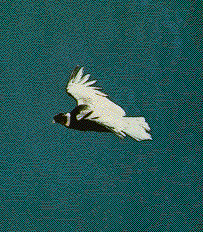
A Smooth and Exciting Ride
In no other breed is the quality of the horses ride judged to be as important as in the Peruvian Paso Horse. The owners continue to insist that the show judges ride the top placing breeding and performance division horses in order to select the winner. The practice allows the judge to better select for such characteristics as brio, smoothness and balance, all traits highly valued in the Peruvian horse. The training methods and riding style or seat for the Peruvian horse are based on the traditional Spanish "a la gineta" way of riding. This Iberian style of horsemanship was used in the battlefield or for work with bulls and cattle and showed a deep seat with bent knees. Combined with a smooth gaited horse, this style gives the most luxurious and safe ride. This incomparable ride has made the Peruvian horse the choice mount for a growing number of Americans. Riding the Peruvian horse down a sandy riverbed with a group of good friends and a full picnic basket redefines the term "pleasure riding". When one can do this with a couple of dynamic show and breeding stallions side by side with a group of beautifully refined mares the regal character and noble temperament of these horses becomes evident. If you enjoy leisurely competition, the Champagne class in one of the many regional shows will surely fit your style. Riders complete several laps and maneuvers with a full glass of Champagne in one hand. The competitor completing the class with the fullest glass is the winner. As the horses are so smooth, even the rider placed last has enough Champagne left to toast his competitors. Peruvian horses showing off with the traditional, hand-crafted saddles and tack are the highlight of many parades throughout the country while ladies riding sidesaddle dressed in elegant, colorful costumes are a feast for the local television crew at different equine events. Peruvian horses in the United States have completed very successfully in competitive trail and endurance events as tough as the famous Tevis Cup. The same horses are being used in many programs for physically challenged children and adults, where the great intelligence and gentle disposition so often found in all Spanish breeds is imperative. For other dedicated horsemen the Peruvian horse offers even greater challenges.
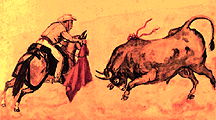
A Challenge for a Lifetime
In many countries around the world, knowledgeable and patient horsemen have found their livesŐ greatest challenge and satisfaction in the breeding and raising of Peruvian Paso Horses. Few breeds require the balanced combination of so many, often contradicting traits and characteristics, to achieve a perfect horse. True brio, one of the most outstanding characteristics of the Peruvian horse, requires the horse to be gentle, responsive and willing to work while delivering an abundance of energy, pride and stamina whenever asked for by the rider. The horse pushing his nose under the handlers arm and asking to be petted will often be the "hottest", most exciting competitor when asked to perform. Another essential trait, the super smooth ride over a wide range of speed, is hard to achieve when the horse is expected to show spectacular motion with high lift and termino. It is equally difficult to breed and train a horse with a high head carriage, a beautifully arched neck and high level of collection, while at the same time reaching far under the body with the hind legs and extending in the front to deliver an efficient ride.
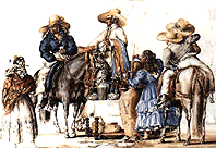
The most challenging aspect in the breeding of Peruvian horses is the requirement that all these traits are to be completely natural. It is not hard to understand the joy and satisfaction every breeder of Peruvian horses displays while watching a six day old foal gaiting in perfect four beat paso llano and carrying his neck and head like a fully trained show horse. If breeding these horses doesn't challenge you, try competitive riding in the many open reining or musical exercise classes now offered at many regional show. The traditional Enfrenadura reining patterns originate from working with bulls and cattle, requiring an exquisitely trained horse and a high level of riding skills. The horse is directed with body weight and leg action and the rider needs great balance and very light hands on the reins. The horse needs to always be alert for the next move and show quick reaction with elegance and flexibility. Over the past years a growing number of Peruvian horse enthusiasts have also discovered that they can be successful in endurance competitions. The legendary stamina of the Barb ancestors carries the Peruvian horse over long distances and the smooth ride certainly makes it easy for the rider to stay in the saddle for these long and tough rides. The Peruvian horse with his versatility and unmatched noble temperament will continue to attract many new aficionados.
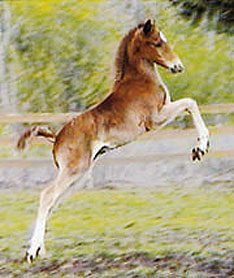
A Bright Future
Today there are approximately 12,000 pure bred Peruvian Paso Horses in the United States. Their number has been growing steadily at a rate close to 10% per year. Over 1500 owners are members of the two established breed organizations and many participate very actively in promotional and other social events organized by over 30 regional clubs. Novice riders and newcomers to the breed find the Peruvian horse easy to ride and once they have experienced the luxurious ride and exquisite temperament they find it hard to stay away from these magnificent horses. The "Caballo Peruano de Paso" is one of Peru's cultural extravaganzas and represents a living monument to this country's heritage. More dedicated owners and breeders around the world are discovering this jewel of a horse each year.